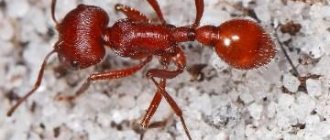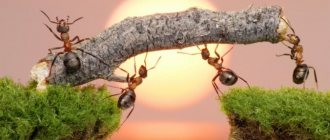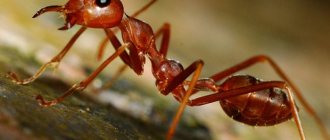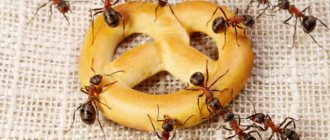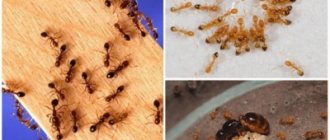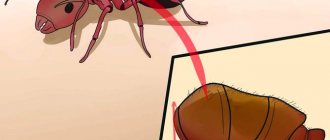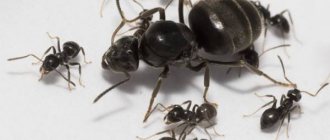Ant: description
The body of an ant consists of 3 main parts, clearly separated from each other - this is the head, which is connected to the chest and abdomen using a thin bridge in the form of a waist. All three parts are covered with a chitinous shell. The eyes of ants consist of a large number of lenses, but they do not allow you to get a good image, but only allow you to react to movement. On top of the head there are 3 additional simple eyes. With the help of 6 thin legs armed with claws at the end, ants are able to move on both horizontal and vertical surfaces. On the ant's head you can see antennae, which serve as organs of touch. With their help, insects detect odors, air fluctuations, and soil vibrations.
Ants mainly live by smell, since by smell they identify their relatives, determine the location of food, give danger signals, etc. Ants can secrete poison or formic acid, which allows them to defend against natural enemies. In addition, ants bite and it hurts very much.
The size of insects depends on the species, as well as on the functions that are intended for all members of the colonies. Therefore, their size ranges from 1 mm to 3 cm. It is characteristic of some species that the size of female individuals is larger than the size of working ants. Females grow wings, which disappear after the fertilization process. Different types of ants also differ in their color patterns. Therefore, there are ants of various colors.
TOP 10 INCREDIBLE FACTS ABOUT ANTS
External structure
Ants are insects that are considered one of the most famous and numerous in the world. Ant size and weight vary depending on the species. Body length can range from 1 to 50 mm. And more often than not, the largest ants are also the most dangerous in the world. Moreover, females are usually much larger than males. Body color depends on the species.
The anatomy of an ant is quite complex. The body of the murash is covered with a chitinous shell. This kind of skeleton not only supports, but also protects the baby. The description of the appearance of different representatives is almost similar. Head, chest and abdomen - this is the structure of the ant. A photo of the ant can be seen below.
Ant close up
Head
The head of an ant is usually large in size; for each individual species it differs in a certain structure. It has powerful mandibles. With them, workers carry food, blades of grass and twigs used for building nests. Mandibles also help insects defend themselves.
Eyes
Not everyone can answer the question of how many eyes an ant has. The insect's eyes have a complex faceted structure. In addition to the paired ones, there are 3 more ocelli. With them, tiny creatures determine the level of illumination and the plane of polarization of the light flux.
Interesting!
With so many eyes, ant species' vision is not the best. Most insects are myopic. Some representatives of this family are not able to distinguish objects, since they do not see at all. They can only react to movements. There are also individuals that respond to the level of illumination of the space.
Mouth
The mouthparts of an ant are of the gnawing type. It includes the jaws, which are also called mandibles or mandibles, the upper lip (labrum) and the lower lip (labium). The mandibles can be large or not very large, excessively sharp or completely blunt. They are also overlapping and interlocking. Thanks to this feature of ants, mandibles can chew food even with their mouths closed.
The organ of taste for goosebumps is the tongue located on the lower lip. Insects also use it to clean their bodies.
Mustache
The sensory organ of insects is the geniculate antennae. They help ants detect odors, detect vibrations and vibrations in the air. In addition, insects use this organ to receive and transmit signals during communication with their relatives.
On a note!
An interesting fact is that only ants have antennae of this structure.
Abdomen
The abdomen of ants is stalk-shaped (the stalk is formed by one or two rings). There may be a vertical growth or notches on it. Some varieties of ants have a sting at the end of their abdomen, which serves as a tool for hunting and their defense. Thanks to it, insects secrete acid - a special substance that paralyzes the enemy.
Paws
The ant has 3 pairs of well-developed legs, each of which is located on a separate thoracic segment and ends in a hooked claw. Thanks to this feature, the ant’s movements can occur not only on horizontal, but also on vertical surfaces. A close-up photo of the ant is shown below.
Ant body
The method of their movement depends on the structural features of the insects' paws. Not all ants move on foot; some species have the ability to jump. There are also gliding insects and runner ants, red fire ants are able to form bridges over water barriers.
The ant's legs serve more than just movement. So, with its front legs, equipped with special brushes, the insect takes care of its antennae. Spurs located on the hind legs are used for attack and defense. And the presence of small serrations on all legs allows insects to move even along steep, smooth surfaces. An example of this is pharaoh ants, which can run quickly on glass.
Types of ants with photos and names
Today, scientists know about 13 thousand species of ants, with about 300 species found within our territories. The species are so similar to each other that it is quite difficult to classify them, especially if a person is not a specialist.
Therefore, it makes sense to pay attention to the most famous and frequently encountered species.
Black garden ant
This species is considered the most common species, since similar ants are found in almost all corners of our planet. Working individuals grow up to 4 and a half mm in length. Males are not significantly characterized. but large in size (up to 5.5 mm), and females have a length from 7 and a half to 11 millimeters. The body of the classic garden ant is covered with short, sparse bristles. They nest deep in the ground, under large stones, and also in unusable (rotten) wood. The main source of food for garden ants is the sweet liquid secreted by aphids. Therefore, ants not only protect aphids, but also breed them on various garden crops, which is why they can cause significant harm to the future harvest. What is interesting: the life expectancy of the queen is about 30 years, which is a record value for this category of insects.
Red myrmica
This type of ant has become widespread both on the European continent and in the Urals, Siberia and the Far East. Females of this species are reddish, up to 6 mm in length, and males are almost black and slightly smaller in size (up to 5 mm). On the body of this species you can also see, albeit sparse, short hairs. They form their nests in the ground, under boulders or under fallen tree trunks.
Small forest ants
They prefer to settle in forests with a temperate climate, distributed throughout the Euro-Asian continent. Ants are distinguished by a red-brown body color, with red cheeks and a black abdomen. They grow in length from 7 to 14 mm. Forest ants form anthills up to 2 meters high in forests. Needles and branches are used as building materials. The species is listed in the Red Books of many countries with endangered species status. Therefore, in some countries, as well as in certain regions, this insect is extremely rare.
Pharaoh ant
Egypt is considered the homeland of this species, but in our time, pharaoh ants have settled in almost all corners of the earth. Working individuals are about 2 mm long and do not have wings. Males are black in color and have wings. They grow up to 3 and a half mm in length. Females also have wings, but only until the moment of mating, after which the males rid them of their wings. They prefer to build nests in dark, moist places. They can be found even in an apartment in a wardrobe or in various household appliances.
Dinoponera gigantea
This species of ants is the largest in the world, since the length of their body is more than 3 cm. The species is distinguished by an almost black color of the body. This species lives in humid environments, in forests common in the Savannah of South America, including the Amazon River basin. This species does not have females, but they are workers who are capable of reproducing. Giant dinosaur ants live in numerous (up to 20-30 individuals) families, the nests of which are formed in the thickness of the earth, at a depth of about half a meter. Males always have wings, so they can fly.
Asian tailor ant
This ant can be found without problems in Australia, Vietnam, Thailand, Bangladesh, as well as in South India in tropical and subtropical climates. This species of ant is distinguished by its bright green color. At the same time, the abdomen is painted in red-orange tones, and the legs are beige. Working individuals are up to 8 mm in length, with males growing up to almost 1 cm in length, and females up to 1.3 cm in length. They prefer to live in trees in colonies of 500 thousand individuals, or even more. Therefore, a colony can occupy several trees at once. They build their nests from leaves, which are connected to each other using the characteristic sticky secretions of the larvae. That's why they were called "tailors".
The population of these places uses the larvae and pupae of these ants as food for poultry, as well as in traditional and folk medicine, including in the national cuisine of some Asian countries.
Eastern Liometopum
It is considered a species that is in danger of extinction, since it is listed in the Red Book, while it is an inhabitant of the Far East. Working individuals are dark brown in color and measure about 6 mm in length. Males and females are almost black and grow to 10 and 12 mm in length respectively. They build their nests in Korean pine, fir, Mongolian oak, linden, birch, etc.
Blood red ant
It is found on almost the entire Eurasian continent, with a preference for the middle zone. Working individuals have an almost black body and a brown head, growing up to 8 mm in length. The uterus is somewhat larger (up to 10 mm), red head and orange chest. Ants make their nests in tree stumps, in the ground, under various objects. With the arrival of winter, they begin to move to nests located at the base of trees. The behavior of this species is that ants raid colonies of other species and capture pupae. After that, they keep them in their nest as “slaves”.
Amazon Ant
Females of this species grow up to 1 cm in length, while males are 2 times smaller, and their “soldiers” are even smaller. The color of females and “soldiers” is yellow-red, and there are black hairs on their body. Males of this species are black in color, with brown antennae and limbs. This type of ant is common in the European part of the continent in western Asia and western Siberia. The species prefers to settle in forests, giving preference to damp areas, near clearings and forest edges. The Amazon ant also practices raids on colonies of other ants and takes pupae with them, after which it keeps them as labor.
Nomadic ants or legionnaire ants
This ant species is a subfamily of nomadic ants, which is common in tropical climates. Entire colonies of these dangerous insects are found in Central and South America, as well as within the African continent. They live in numerous colonies, consisting mainly of working individuals. Despite their relatively small size (no more than 4 mm), colonies of these insects are capable of destroying everything in their path. At the same time, they cause enormous damage to farmland.
Types of ants
The science of ants - myrmecology, currently knows about 13 thousand species of these insects, but even more remain to be discovered. Discovering new species is quite difficult due to the fact that among ants there are many twin species, as well as hybrids, which are difficult to distinguish by external characteristics, which greatly complicates their classification. Because of this, it is impossible to know absolutely everything about ants.
The most interesting types of ants can be included in a separate list:
- The black garden ant is a very famous species, which is especially common in Portugal, Great Britain and central Russia. Working individuals are no more than 4.5 mm, while males are capable of reaching 5.5. Females are much larger, ranging from 7.5 to 11 mm. The black ant's body is covered with small hairs. Anthills are made in rotten wood; simple soft earth or a large stone will also work. Since their main food source is honeydew, they cause serious damage to agriculture by preserving and breeding various insects that excrete it. Another distinctive feature of the species was the incredible lifespan of the queen - up to 30 years.
- Small forest ant - the habitat of this species includes almost the entire territory of the northern part of Eurasia. Wood ants reach a size of 7 to 14 mm, have a black abdomen, red-brown body color and red “cheeks”. The anthill can grow up to two meters in height.
- Dinoponera is gigantic - reaches 33 mm in length. They can live only in the savannas of South Africa, where this species is often called Dinosaur. Lives in small groups of 20-30 individuals. An important distinguishing feature is the absence of a uterus. Her role is played by simple females who are capable of reproducing, unlike other species, where these individuals are frigid. The anthill is usually located underground, at a depth of up to 40 cm.
- The blood-red ant, also known as the “slave trader,” has a wide habitat in Europe and central Russia, and can be found in Mongolia and China. The workers have a black body and a red head, their size is no more than 8 mm. The queen is slightly different in color, having a red head and orange breast. Its length can reach 10 mm. In summer, the colony can live in half-rotten stumps, simply under the ground or stones. The main feature of their way of life is raids on other anthills in order to seize their resources. They even kidnap larvae, which subsequently grow up in the lair of new “masters” and begin to work, like other working individuals. Despite this, they are often called "slaves".
- Dorilins, or nomadic ants, live in the subtropics and tropics. They have widely spread throughout South and Central America. They travel in giant colonies, destroying everything they meet along the way. Despite their small size (2-4 mm), they try to kill in numbers, and one dead individual is replaced by ten at once. Nomads cause enormous harm to agriculture, as they completely destroy cultivated plants.
Due to difficulties in studying, many species of ants still remain undiscovered. There are also no answers to many questions about the social life of these insects, which is often compared to human society.
Natural habitats of ants
If we take into account all types of ants, and there are more than a thousand of them, then they are found on almost all continents and in all climatic zones. Therefore, they are found both in deserts and in the Arctic and Antarctic conditions. In cold climates, ants hibernate in winter.
Their nests can be seen in rotten wood, in the soil, and also under various objects lying on the ground. Some species do not build nests for themselves, but prefer to take over others. Many species prefer to live near humans.
How do ants live?
Ants live in families in nests. An ant family is formed over many years, as a result of which the number of inhabited anthills can be several million (colonies located near each other over vast territories). Basically, these insects build anthills for themselves in rotten or rotten wood, in the soil and under small stones. Some species of ants invade other people's nests or live near humans. Ant society is divided into three castes: females, males and workers. The division of labor takes place according to class. Moreover, all residents of the colony, from the queen to the worker, are required to perform their functions at the proper level. Some get food, others do construction, and soldier ants defend the nest.
Diet of ants
Each species of these insects feeds differently, so it is almost impossible to single out specific food. The fact is that they consume food items of both plant and animal origin. However, they can eat quite often.
For normal growth and development of ant larvae, protein is required, the source of which is dead insects, as well as the remains of other animals, trophic eggs laid by the queen, eggs of various harmful insects, as well as semi-digested food of adults.
House ants use dairy products, gelatin, and leftover egg dishes as a source of protein food. The queen ant also consumes protein food, which she receives from the individuals caring for her.
Ants obtain carbohydrates from honeydew, as well as from the liquid secreted by aphids.
Ants are unique living creatures that form entire farms from aphids, after which they “graze” them and protect them from attacks by other ants. As a result, the ants provide their own food.
In addition, ants in nature try to feed on plant seeds, nuts, and green juices. Some species breed entire colonies of mushrooms in their nests, while also feeding on caterpillars and insects.
Harvester ants feed on dry plant seeds, dry fruits, and grain crops. They store up to 1 kg of nutritious material for the winter, which is enough for the entire colony.
Leaf-cutter ants stock up on pieces of leaves, after which they chew them and store them in this form in special chambers. After some time, mushrooms appear on the chewed pieces, which represent the main food source for this family. Centromyrmex ants eat termites exclusively. Dracula ants feed on substances that their larvae secrete, and the larvae eat various insects. We can safely say that these ants are gourmets, which cannot be said about domestic ants, which are omnivores.
When there is a significant cold snap, the ants hibernate, so they do not feed during this period. Some of the species continue to lead an active lifestyle, surviving on the created reserves.
Ant Reproduction
Ants reproduce 2 times a year, and 2 methods are available for them.
The first method is based on the fact that the young female takes with her a certain number of workers and leaves her family to form a new family. As a result of the second method, the female goes on a mating flight, where she is fertilized by males from another anthill. After fertilization, the female lays eggs, after which, after they mature, she has a group of working individuals. The males die after some time. Until the workers mature, the queen feeds on the remains of the muscles of her wings. Females and workers are born from fertilized eggs, and males from unfertilized eggs.
Ants are considered harmless insects until they come into the sight of a person in the home. Although even in a home they cannot cause harm, except perhaps by their movements in search of food. Therefore, they should not be exterminated, since they destroy many harmful insects.
How does an anthill work?
Ants are social insects and their life activity is somewhat reminiscent of human life, where society consists of people of various professions.
Their home (anthill) has a unique structure, which only the mind can do. For example:
- Ants are engineers and builders who form their nest through tunnels and other communications.
- In the society of ants, there are soldiers who protect the anthill from attacks by natural enemies, and also help to capture other territories.
- Doctor ants monitor the health of working individuals and also perform operations, relieving individuals of injured legs.
- Nurse ants control the development of larvae.
- Foraging ants are busy collecting and storing food, distributing it into special storage areas.
- Farmer ants are busy breeding aphids, cicadas, copperheads and scale insects. They look after them and also “milk” them, obtaining a tasty liquid.
- Leaf-cutter ants are busy collecting and identifying leaves, after which colonies of fungi grow from them. There are also ants - fungal growers, who use both insects and feces to grow mushrooms.
- Harvester ants are busy collecting seeds from various plants.
- Carpenter ants are busy collecting juices secreted by various plants.
- Gravedigger ants practice moving their deceased relatives to a place that can be called a cemetery.
- These are not all professions that allow an ant colony to survive in natural conditions.
What does an ant look like?
The ant belongs to the class insects. The body structure of an ant has three components: head, chest and abdomen, connected at the waist. The eyes, which are made up of multiple lenses, can detect movement but do not provide a clear image. Ants move with the help of six thin legs, which have claws, which allows the insect to climb up. The antennae located on the head are organs of touch and allow them to detect odors, air currents and soil vibrations. Smell plays a big role in the life of ants: with the help of smell, ants distinguish members of their community from other insects, learn about the location of food, and sound an alarm or call for help. The size of ants and the structural features of the insect depend on the species, as well as the status occupied in the colony and range from 1 mm to 3 cm. The color of ants can be absolutely diverse. The gradient varies from red, yellow, black and brown to green and bluish colors. In some species, females are the largest individuals; in others, the size of females does not exceed the size of working individuals. The female ant (queen) and males have wings, while the workers are wingless. The females shed their wings after the mating season. Winged ants are not a separate type of insect, but specific winged individuals that appear in the spring and summer for the purpose of reproduction.
Interesting facts about ants
- The bullet ant, which lives in tropical conditions, can bite by injecting a fairly potent poison that causes pain in the victim, which is several times greater than the sensation of a bee or wasp sting. Indian tribes who know this teach their younger generation to be resistant to severe pain. To do this, they place the boy's hand in a plastic bag with these insects. As a result of numerous bites of these insects, the hand begins to swell, and the person feels incredible pain.
- Ant eggs are nothing more than larvae, and some tribes in Africa and residents of other Asian countries have no problem including them in their diet. Many believe that larvae contain a lot of protein, and plus, eating them increases potency. Mexicans generally spread these eggs on corn tortillas and eat them with pleasure on holidays, like many nationalities eat red caviar.
- The queen, on which the life of the colony depends, can live for about 6 years. Moreover, there is evidence that the queen was able to live for as long as 14 years, which is an absolute record for the insect order.



